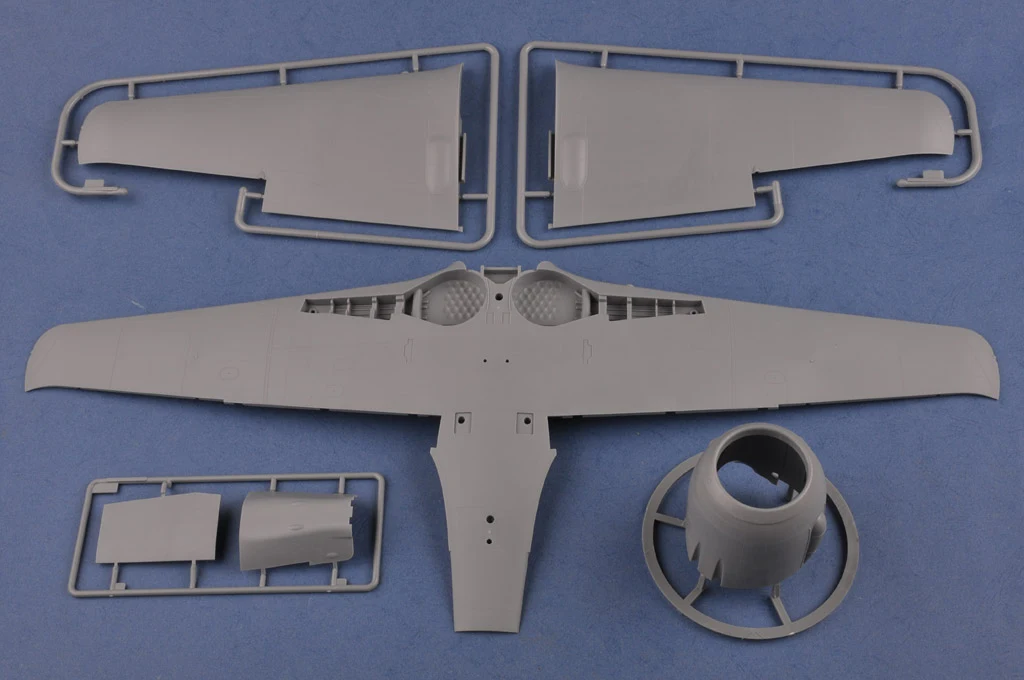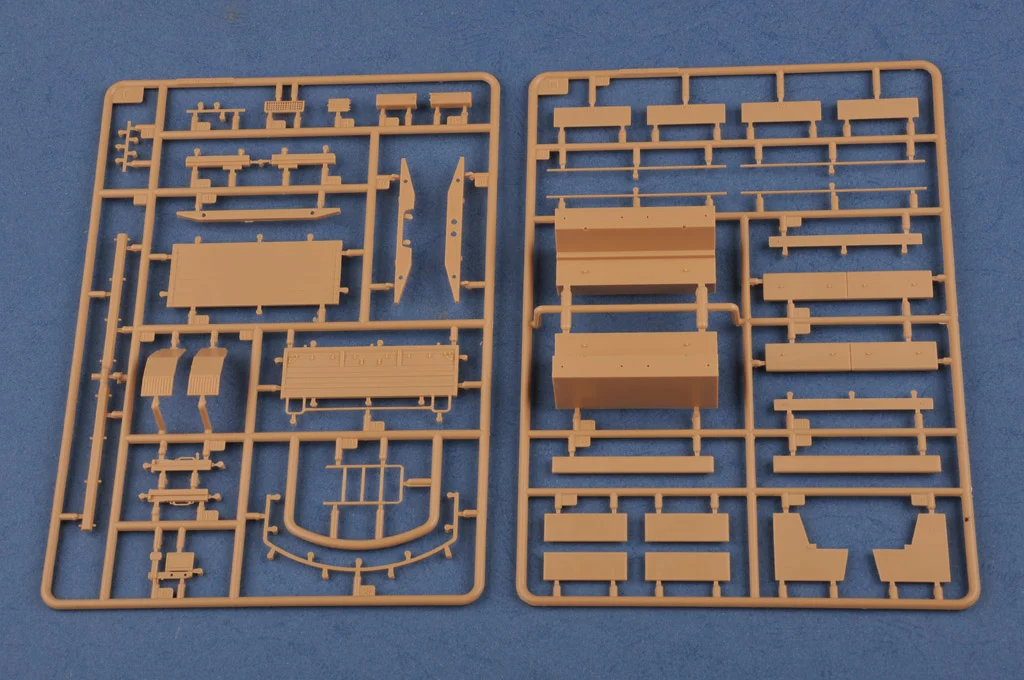

Hobbyboss have four new models ready for us in October - A Butcher Bird the size of like we don't often see, a Kraz with an explosive payload, a real MAN's truck and an Imperial vessel all out to sea - See what we are on about in our preview that includes markings and sprues…


Hobbyboss’ new items for
September 2017





Focke-Wulf FW190A-5
Model:81802
1:18th Scale
The Fw 190 A-5 was developed after it was determined that the Fw 190 could easily carry more ordnance. The D-2 engine was moved forward another 15 cm (6 in) as had been tried out earlier on the service test A-3/U1 aircraft, moving the centre of gravity forward to allow more weight to be carried aft. Some A-5s were tested with the MW 50 installation: this was a mix of 50% methyl alcohol and 50% water, which could be injected into the engine to produce a short-term power boost to 2,000 PS (1,973 hp, 1,471 kW), but this system was not adopted for serial production. New radio gear, including FuG 25a Erstling IFF, and an electric artificial horizon found their way into the A-5.The A-5 retained the same basic armament as the A-4. 1,752 A-5s were built from November 1942 to June 1943.
The A-5 U2 was designed as a night Jabo and featured anti-reflective fittings and exhaust flame dampeners. A centre-line ETC 501 rack typically held a 250 kg (550 lb) bomb, and wing-mounted racks mounted 300 L drop tanks. An EK16 gun camera, as well as landing lights, were fitted to the wing leading edge. The U2 was armed with only two 20 mm MG 151 cannon. The U3 was a Jabo fighter fitted with ETC 501s for drop tanks and bombs; it too featured only two MG 151s for armament. The U4 was a "recon" fighter with two RB 12.5 cameras and all armament of the basic A-5 with the exception of the MG FF cannon. The A-5/U8 was another Jabo-Rei outfitted with SC-250 centreline-mounted bombs, under-wing 300-litre drop tanks and only two MG 151s; it later became the Fw 190 G-2. A special U12 was created for bomber attack, outfitted with the standard 7.92 mm (.312 in) MG 17 and 20 mm MG 151 but replacing the outer wing 20 mm MG-FF cannon with two underwing gun pods containing two 20 mm MG 151/20 each, for a total of two machine guns and six cannons. The A-5/U12 was the prototype installation of what was known as the R1 package from the A-6 onwards. The A-5/R11 was a night fighter conversion fitted with FuG 217 Neptun (Neptune) radar equipment with arrays of three dipole antenna elements vertically mounted fore and aft of the cockpit and above and below the wings. Flame-dampening boxes were fitted over the exhaust exits.
Model Dimensions Length: 490.5mm Wingspan: 583.5mm
Total Plastic Parts 110+
Total Sprues 14 sprues, wing and tires
Metal Parts - hinge, pin, screw, spring
-Left and right fuselage moulded w/ authentic details
Interior
-Finely detailed gear cabin
-Finely detailed cockpit
Wings
- Newly tooled wings accurately represent real ones
- moveable flaps
Undercarriage
- Optional open or close
LKW 5t mil gl
Model:85507
1:35th Scale
Introduced between 1976 and 1985, the types 451 and 461 are powered by a Deutz V8 Diesel engine, type F8L413F with 256 hp. These trucks are mainly flatbeds and covered wagons used to transport material and troops, carriers for the Kabine II of the fire control system (FERA) of the Light Artillery Rocket System (LARS) and as a recovery vehicle for the KZO "Brevel" drone, equipped with a 1-ton crane by Atlas-Weyhausen.
A speciality is the tank trucks based on the 5 t mil gl. With the tank attachment ("Tankaufsatz", TA) with pump, either with 1x 4600 l or 2x 2300 l tanks, they exceed the max. gross weight by one ton. After tests and with the consent of the tire manufacturer, it was decided to increase the tire pressure to compensate. All of these vehicles have a certificate of exemption.
In contrast to type 451, the type 461 vehicles are equipped with a 5-ton winch with 30m of steel cable, denoted by the letter "w" in their designation (5 t mil glw). The cable can be played out to the front and to the rear. Almost all of the 2,073 winch-equipped trucks went to the army branch.

Between 1986 and 1993, the German Air Force (Luftwaffe) ordered further vehicles which could be airlifted in Lockheed C-130 Hercules and Transall C-160 transport aircraft. This new generation, termed KAT I A1, had some minor improvements over the first generation and some slight modifications. For example, the fixed cab was modified to expedite changing the engine. For airlift, the cab received a bolt-on hardtop.
Model Dimensions Length: 229mm Width: 71.4mm
Total Plastic Parts 520+
Total Sprues 12 sprues, cab and tires
Photo-Etched Parts
Detailed multi-directional slide-moulded cab
Full drive train assembly complete with engine transmission, differential housing and suspension units.
The main tires are hollow rubber with very good tread pattern
Wheel hubs are in great detail
SMS Seydlitz
Model: 86510
1:350th Scale
SMS Seydlitz was a 24,988 metric tons (24,593 long tons; 27,545 short tons) battlecruiser of the Imperial German Navy, built in Hamburg. She was ordered in 1910 and commissioned in May 1913, the fourth battlecruiser built for the High Seas Fleet. She was named after Friedrich Wilhelm von Seydlitz, a Prussian general during the reign of King Frederick the Great and the Seven Years' War.
Seydlitz represented the culmination of the first generation of German battlecruisers, which had started with the Von der Tann in 1906 and continued with the pair of Moltke-class battlecruisers ordered in 1907 and 1908. Seydlitz featured several incremental improvements over the preceding designs, including a redesigned propulsion system and an improved armour layout. The ship was also significantly larger than her predecessors—she was approximately 3,000 metric tons heavier than the Moltke-class ships.
Model Dimensions Length: 573.3mm Beam: 81.4mm
Total Plastic Parts 520+
Total Sprues 10 sprues and decks
Metal Parts anchor chain
Photo-Etched Parts
More Features -hull split into two parts
-Deck wood pattern finely rendered
-Contains display stand and engraved nameplate
-Photo-Etched parts included




Russian KrAZ-260B Tractor with 5P85TE TEL S-300PMU
Model:85511
1:35th scale
Product Link
Production of the KrAZ-260 began sometime during the early 1980s when it replaced the earlier KrAZ-255B on the production lines at the Kremenchug Motor Vehicle Plant. However, the vehicle was not disclosed to the general public until 1985 when examples were displayed towing 152-mm2A36 nuclear-capable field guns during a Red Square parade - the KrAZ-260 can tow loads of up to 10000 kg when fully loaded (30000kg when empty). TheRed Square example had an open body equipped with forward-facing bench seats although this had been a parade configuration. The normal body uses a conventional cargo body with tailgate all covered by the usual tilt over bows. A winch is a standard fitting under the cargo body and can be employed for either forward or rearwards recovery, including self-recovery.
The overall appearance of the KrAZ-260 is similar to that of the earlier KrAZ-255B but the bonnet is more angular to accommodate the turbocharged diesel engine, and the overall dimensions are slightly larger. As far as can be determined the KrAZ-260 was produced for military service only and as apparently not been delivered to armed forces outside the Soviet Union.
Variants are known to exist include the KrAZ-260V tractor truck, used to tow a variety of semi-trailers, and the KrAZ-240. It was also used to tow platforms with S-300 missiles. This tractor truck has a 6x4 drive configuration, a slightly longer wheelbase (4,88 m+1.4 m) and an on-road load capacity of 16.8 t; it is used for long-range logistic support duties, leaving the KrAZ-260 for the forward area load carrying.In 1999 this heavy utility truck was succeeded with improved KrAZ-6322.
Model Dimensions Length: 403.2mm Width: 94.7mm
Total Plastic Parts 890+
Total Sprues 26 sprues and tires
Photo-Etched Parts
Full drive train assembly complete with engine transmission, differential housing and suspension units.
The main tires are hollow rubber with very good tread pattern
Wheel hubs are in great detail
These kits will all be available from Hobbyboss’ Distributors sometime in September/ October 2017.




























